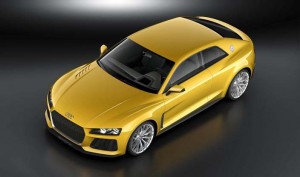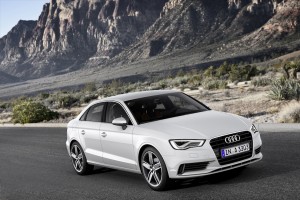It’s a race to the finish as the year winds down and BMW and Mercedes-Benz ramp up their efforts to position themselves as America’s best-selling luxury brands, a battle they’re repeating in other markets around the world.
But the two makers are spending a lot of time looking over their corporate shoulders lately as the upstart Audi takes aim – and rolls out a massive investment program that it hopes will make it the world’s biggest luxury brand before the end of the decade.
The Volkswagen AG luxury brand has announced plans to spend 22 billion euros, or $30.3 billion, between now and 2018, to add new models, bolster its presence in the emerging electric vehicle market, and add capacity around the world.
“We are now decisively steering toward our next milestone,” said Audi CEO Rupert Stadler in a statement outlining Audi’s expansion plan. “This is why we’re keeping our foot on the gas pedal regarding investments.”
Audi has already nudged past Daimler AG’s Mercedes-Benz brand but still lags behind the global luxury leader, BMW AG. But it doesn’t intend to be second for long.
Of the total investment it plans, 70%, or 15.4 billion euros, will go into new vehicles and new technologies. By 2020, it expects to be marketing a total of 60 different models, up from 49 today. It is already in the midst of rolling out a new generation of A3 models – the U.S. debut scheduled for 2014 – while it is preparing a replacement for its TT next year, and an all-new Q1 compact luxury crossover in 2016.
(Audi’s all-wheel-drive models helping maker gain traction. Click Herefor the story.)
Audi also has been rapidly expanding its alternative powertrain technologies, including both a plug-in version of the new A3, as well as a variant using compressed natural gas.
The company, based in Ingolstadt, in southern Germany, also plans to boost production capacity sharply. It has announced new plants for Mexico, Brazil and China, Audi already being the best-selling luxury brand in that booming Asian nation.
Sales this year will top 1.5 million – a figure it will have reached about two years ahead of its earlier target – and it wants to top 2 million as part of the new expansion plan.
(Audi to roll out four versions of all-new A3 line. Click Here for a closer look.)
“With this investment program we are launching our next stage of growth,” said Audi Chief Financial Officer Axel Strotbek.
That’s not to say that Audi doesn’t have some obstacles to clear. While the maker has been growing rapidly in the critical U.S. market, it still lags well behind rivals BMW and Mercedes, as well as Japan’s Lexus.
Meanwhile, its key German competitors are planning to ramp up both production capacity and their own model counts as they also bid for luxury leadership.
BMW, for example, has announced plans to launch 25 new models through the end of 2014 – 10 of which are entirely new to its BMW, Rolls-Royce and Mini brands. The maker has also been boosting production capacity at many key plants, including its U.S. facility in Spartanburg, South Carolina. BMW is also betting big on battery power, the maker just rolling out an all-new sub-brand of green vehicles such as the new i3.
Daimler, meanwhile, is boosting its own line-up. It recently launched the all-new CLA, the compact luxury sedan its fastest-growing model in the U.S. A new crossover, the GLA, using the same underlying platform, has just gone into production. All told, Mercedes plans 13 new models by decade’s end. And it is also investing heavily in alternate propulsion technologies.
Audi’s ambitions could prove critical for the parent, VWAG. Volkswagen is pursuing its own goal of becoming the world’s largest automotive manufacturer – overtaking current leader Toyota Motor Co. and number two General Motors Corp. – by 2018.



The Euro car makers are working themselves right into a corner like the Big three have done over the years by over production of models and it will catch up to them eventually as it did the Big Three. Ego driven businesses have a way of biting their CEOs in the butt.